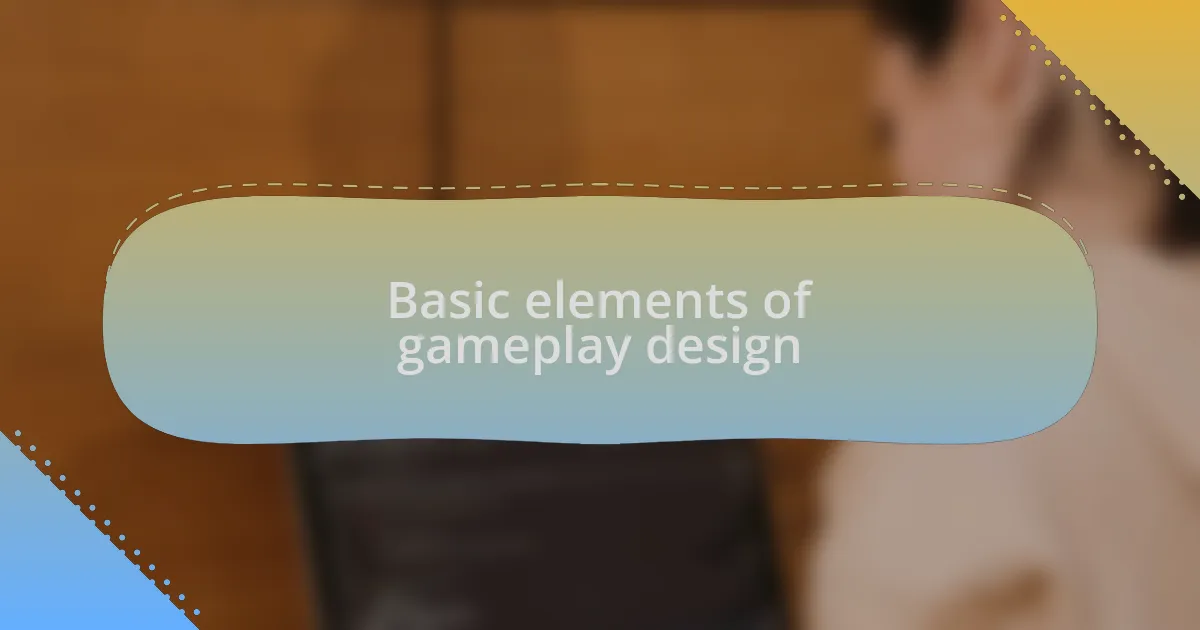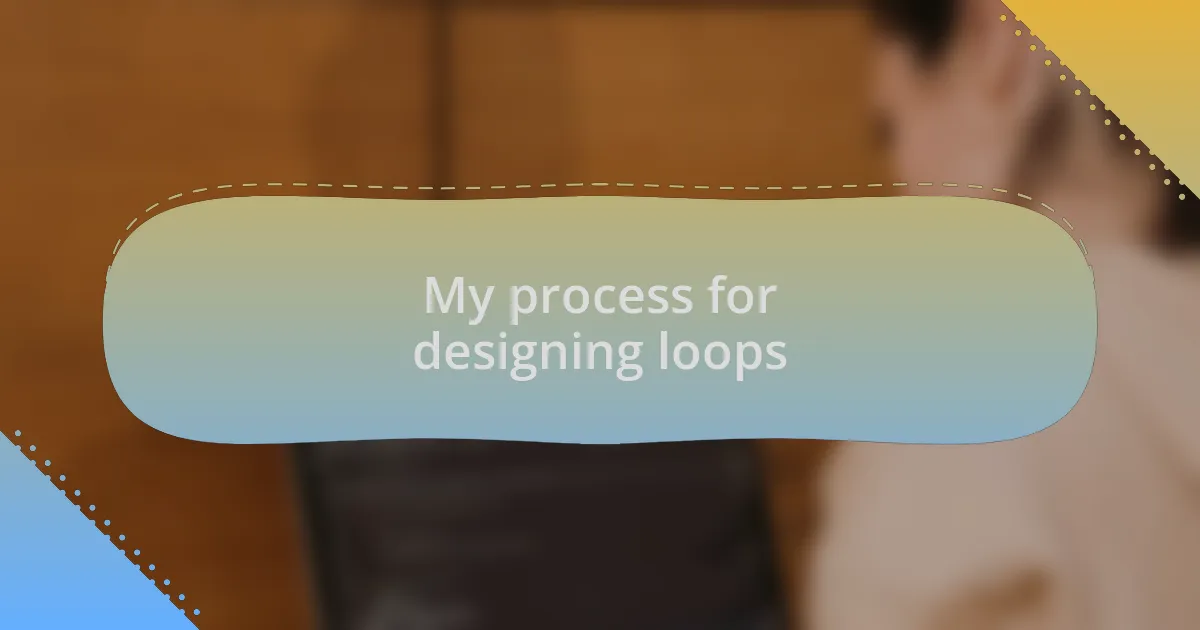Key takeaways:
- Gameplay loops consist of three key elements: action, feedback, and reward, crucial for player engagement and satisfaction.
- Effective feedback systems enhance the player’s experience, creating a strong emotional connection between actions and gameplay.
- Continuous iteration and collaboration are essential in designing gameplay loops, allowing for refinement based on player feedback.
- Balancing challenge and reward, along with maintaining consistency in mechanics, is vital for sustaining player motivation and engagement.

Understanding gameplay loops
When I first delved into game design, the concept of gameplay loops fascinated me. A gameplay loop essentially refers to the cycle of actions that players repeat throughout a game, creating a rhythm that keeps them engaged. Have you ever found yourself replaying a level just to experience the thrill again? That’s the power of a well-crafted gameplay loop.
At its core, a gameplay loop consists of three key elements: action, feedback, and reward. Take, for example, a simple farming game where you plant seeds, wait for them to grow, and harvest the crops. Each phase not only flows into the next but also reinforces the player’s sense of accomplishment. I remember feeling that rush when I finally harvested a large crop after days of waiting. It’s a moment that makes the game feel rewarding and immersive.
Moreover, creating distinct gameplay loops involves understanding how to balance challenge and reward. I often ask myself, “What keeps players coming back for more?” It’s crucial to implement mechanics that entice players while providing just enough difficulty to feel fulfilling. One time, I adjusted the timing of a puzzle-solving loop in my own project, which suddenly transformed the player experience. Seeing that increase in engagement reaffirmed the importance of thoughtful gameplay design.

Importance of gameplay loops
Gameplay loops are essential because they establish a foundation for player engagement. I once developed a platformer game where the loop consisted of jumping, collecting items, and avoiding obstacles. Players often expressed their excitement after mastering a tricky jump, which made me realize how crucial it is for gameplay loops to evoke strong emotions, keeping players invested and eager to improve.
The importance of feedback in gameplay loops cannot be overstated. I recall tweaking the feedback system in one of my games—adding visual effects and sound cues after a successful action made a world of difference. It’s fascinating how these sensory responses can enhance a player’s experience, creating a vibrant connection between their actions and the game world.
Lastly, a well-constructed gameplay loop fosters a sense of progression and achievement. During my early days, I worked on a game where players leveled up characters through repeated actions. Witnessing players beam with pride after reaching a new level or unlocking a special ability reinforced my belief that rewarding experiences within gameplay loops can lead to lasting memories. How often do we chase that next level, yearning for the satisfaction it brings?

Basic elements of gameplay design
When I think about the basic elements of gameplay design, I can’t help but emphasize the importance of mechanics, dynamics, and aesthetics. Mechanics are the rules and systems governing gameplay; in one of my projects, I designed a puzzle game where players had to manipulate blocks to progress. The thrill of discovering a new solution was palpable and reminded me how mechanics lay the groundwork for player engagement.
Dynamics take things a step further by considering how these mechanics interact with players over time. I remember developing an RPG that encouraged players to form strategies based on character strengths and weaknesses. The dynamic interplay of player choice and consequence not only challenged their skills but also created those memorable moments of surprise and delight. Have you ever strategized over your next move and felt that rush when it paid off?
Lastly, aesthetics play a huge role in shaping the player’s emotional experience. I vividly recall collaborating with an artist on a side-scrolling adventure game, where the visuals and sound design truly brought the game world to life. The colors and music created an immersive atmosphere, enhancing the emotional impact of every challenge faced. It’s incredible how the right aesthetics can transform a good game into an unforgettable journey, leaving players longing to return.

Analyzing effective gameplay examples
Effective gameplay examples often strive to create a feedback loop that reinforces player engagement. I recall playing “Celeste,” a platformer that masterfully uses its gameplay mechanics. Each time I died, I felt the frustration, but simultaneously, it motivated me to try harder. This push-and-pull dynamic not only refined my skills but made each victory incredibly satisfying. Don’t you find that sense of achievement addictive?
Another great example is “Stardew Valley,” where time management becomes a thrilling challenge. In my own experience, balancing farming, relationships, and events was both exhilarating and stressful. The game’s ability to provide constant rewards—whether through crop yields or friendship levels—kept me hooked. Have you ever lost track of time while immersed in a world that feels both fulfilling and overwhelming?
Additionally, let’s not overlook the narrative aspect of gameplay. In “The Last of Us,” character-driven storytelling actively shapes gameplay decisions. My heart raced during moments that forced me to choose between survival and compassion, enhancing my emotional investment in the characters. How often do you find yourself weighed down by such choices in a game, thinking about the implications beyond mere pixels on a screen? These examples illustrate how effective gameplay loops are intricately layered, blending mechanics, dynamics, and aesthetics in a way that resonates with players long after they step away from the screen.

Tools for creating gameplay loops
When it comes to creating engaging gameplay loops, the right tools can make all the difference. I often turn to game engines like Unity and Unreal Engine because they come packed with features that support rapid prototype development. These platforms allow me to test my ideas in real-time, enabling me to see how changes in mechanics can impact player engagement. Have you experienced the excitement of watching your gameplay loop come to life with just a few adjustments?
Another aspect I find incredibly useful is data analytics tools. By closely analyzing player behavior, I can identify which elements of my gameplay loop are working and which aren’t. I remember a project where I used telemetry data to understand where players got stuck in a level. It was enlightening! The insights allowed me to tweak my design and ultimately enhance the player’s experience. Do you keep track of player interactions to refine your designs?
Lastly, utilizing prototyping tools like Figma or Sketch can foster creativity in designing user interfaces and gameplay elements. I once designed a user interface for a mobile game that visually conveyed the progression loop, and it dramatically increased player satisfaction. Having a clear visual representation helps solidify the gameplay loop in both my mind and the players’, making the connection more intuitive. What tools do you find indispensable when mapping out a gameplay experience?

My process for designing loops
When I set out to design gameplay loops, I start by envisioning the core experience I want players to have. I ask myself, “What feeling do I want to evoke in the player?” This question often guides my decisions, from the mechanics I choose to the rewards I implement. For instance, during one of my projects, I focused on creating a sense of accomplishment through well-timed rewards, which profoundly impacted player satisfaction.
As I move further into the design process, I prioritize iteration. I create multiple versions of my loops and test them rigorously. I remember a game where I thought a specific combat mechanic would be thrilling, only to find it lacked engagement. By tweaking the timing and adding layers of strategy, I saw the player’s excitement rise, and that instant feedback was both gratifying and enlightening. Do you also find that iteration often uncovers hidden gems in your design?
Collaboration plays a key role in my loop design too. I frequently lean on feedback from my team or playtesters. Their perspectives often reveal insights I might overlook. For example, after sharing my latest loop with a few colleagues, one suggested a shift in pacing that transformed the entire flow of the gameplay. It’s fascinating how a simple conversation can lead to profound enhancements. How often do you seek out fresh eyes on your projects for new inspiration?

Tips for refining gameplay experience
When it comes to refining the gameplay experience, I find that balancing challenge and reward is crucial. One time, I introduced a particularly difficult level without adequate rewards. The frustration among players was palpable, and it taught me that a well-timed reward can rejuvenate motivation and engagement. I often ask myself, “Did I give players enough at the right moments to keep them hooked?” Finding that sweet spot is an art.
I’ve also learned the importance of consistency within gameplay mechanics. I vividly recall a project where I introduced a unique mechanic late in the game. Although it added excitement, it confused players who hadn’t had time to adapt to the new rule. Reflecting on that, I now strive for a consistent set of mechanics that allow players to build their skills progressively. Have you noticed how players thrive when they can predict outcomes based on previously learned skills?
Moreover, players’ feedback often reveals the nuances that I might miss. I remember a playtesting session where a player’s simple comment about the lack of visual indicators for health status changed everything. It was a small tweak, but it significantly enhanced game intuitiveness, making players feel more in control. Have you ever experienced a moment where a tiny detail made a massive difference? Seeking and embracing such feedback is essential for a more polished gameplay experience.